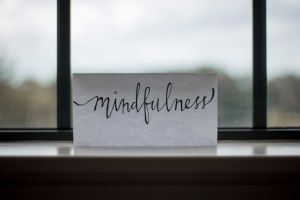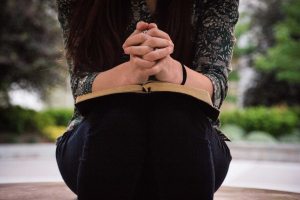 Mindfulness is the practice of allowing your mind to quiet and focus on what is happening in the present. As thoughts, memories, and emotions come into awareness, we learn to acknowledge them and let them pass. We do not judge what comes into our awareness nor do we actively fight it either. We maintain a sense of openness, curiosity, and acceptance.
Mindfulness is the practice of allowing your mind to quiet and focus on what is happening in the present. As thoughts, memories, and emotions come into awareness, we learn to acknowledge them and let them pass. We do not judge what comes into our awareness nor do we actively fight it either. We maintain a sense of openness, curiosity, and acceptance.
Mindfulness means maintaining a moment-by-moment awareness of our thoughts, feelings, bodily sensations, and surrounding environment, through a gentle, compassionate lens. When we practice mindfulness, our thoughts tune into what we sense in the present, rather than revisiting the past or worrying about the future.
Mindfulness isn’t difficult. We just need to remember to do it. – Sharon Salzberg
Mindfulness is not a religious practice although some religions do use mindfulness practices. It is a very beneficial mental health practice that can help us not just react to life around us or spend too much time focused on the past or worrying about the future. Mindfulness is about being present and attentive to the unfolding experience around us. It is about being fully tuned in to what is happening now.
For God alone, O my soul, wait in silence, for my hope is from him. – Psalm 62:5
Countless scientific studies have revealed the benefits of maintaining a formal daily mindfulness practice. Mindfulness practices have moved into mainstream medical and mental health arenas. In fact, many major medical centers around the country have maintained mindfulness-based clinics for years.
Harvard has maintained a mindfulness-based stress reduction clinic for over 25 years. Patients dealing with an array of issues are enrolled in an intensive 8-week mindfulness-based stress reduction program. Some patients are very skeptical and reluctant to enroll. Yet upon completing the rigorous 8-week program, a large percentage choose to reenroll and continue.
Science reveals that mindfulness practices can help treat anxiety, depression, insomnia, high blood pressure, gastrointestinal issues, obsessive compulsive disorder, post- traumatic stress disorder, and chronic pain to name just a few. Many studies have documented the effectiveness of this practice. Mindfulness can also boost the immune system by lowering our stress level and promoting relaxation.
Our breath is the only part of our automatic body processes that we can also control. For example, you go about most moments of your life breathing in and out without giving it a thought. You don’t forget to breath, it just happens.
 However, you can also take control of your breathing for short periods of time and decide to slow your breathing down or speed it up. It’s up to you. Deep breathing helps calm the amygdala, a structure in the emotional part of the brain that evaluates what is going on around us.
However, you can also take control of your breathing for short periods of time and decide to slow your breathing down or speed it up. It’s up to you. Deep breathing helps calm the amygdala, a structure in the emotional part of the brain that evaluates what is going on around us.
If something threatening or difficult is going on, our sympathetic nervous system gets activated and we go on high alert. This is needed if we are really in danger (e.g. – we need to outrun an angry dog or dash after our child that is running toward the street). But we are not meant to live in this high-alert state. Deep breathing is an effective way to calm the amygdala down and turn on our parasympathetic nervous system on – the part that calms us down and helps us to return to a state of equilibrium.
It is quite easy to begin a basic mindfulness practice in your own home. All you need is a comfortable quiet spot to sit for about 10 minutes. I would recommend setting a timer for 10 minutes to alert you when your mindfulness practice is ending.
First, you sit with feet flat on the floor, back straight and arms and hands relaxed. Notice how your feet feel on the floor, how the weight of your body rests in the chair, and how your hands rest lightly on your thighs. Allow your gaze to soften. Then take several deep breaths, breathing in through your nose or mouth – whichever comes naturally.
I would suggest breathing in to the count of 4 and exhaling to the count of 8. A great beginning practice is to pay attention to the breath – noticing the natural rhythm and flow of the breath. If a thought, memory or emotion grabs your attention, simply acknowledge it without judgment and then return your focus to your breath.
You may become distracted several times during the 10 minutes but this is of no concern. Our mind is a busy place. Just continue by refocusing on your breath. As your timer sounds, take a few moments to think of something that you are really grateful for. Then gently focus your attention back on the room.
Be happy in the moment, that’s enough. Each moment is all we need, not more. – Mother Teresa
On any given day, you may not feel your formal mindfulness practice has benefitted you. Please do not judge the value of any particular mindfulness session. I would encourage you to commit to continuing a daily practice. It is easy to add a daily practice if you will attach your practice to an activity you are already doing.
Perhaps you shower first thing in the morning. You could then do your mindfulness practice right after that. In this way, your practice gets woven in to the threads of your day. Many people report great benefits to adding a second mindfulness session before bed. At that time, this can help still your mind and relax your body, allowing for a better transition into sleep.
 Mindfulness practices can help us move past difficult feelings such as resentment or unforgiveness. Basic visualization techniques can allow us to envision a difficult emotion floating away on a balloon, written in the sand and washed away by the surf, or written on paper and then burned up in a fire. If you prefer, you can actually write down the difficult emotion you are struggling with and then tear the paper into bits or burn the paper in a candle flame.
Mindfulness practices can help us move past difficult feelings such as resentment or unforgiveness. Basic visualization techniques can allow us to envision a difficult emotion floating away on a balloon, written in the sand and washed away by the surf, or written on paper and then burned up in a fire. If you prefer, you can actually write down the difficult emotion you are struggling with and then tear the paper into bits or burn the paper in a candle flame.
Informal mindfulness practices spread across your day can also be beneficial. You can eat or drink mindfully, bringing your attention to the flavor, texture, and smell of your food or drink. You can walk mindfully, fully turning your attention to what your five senses are taking in as you walk: the lovely trees and flowers you pass, the smell of freshly mown grass, the sound of the birds in the trees, or even the feel of the grass, sand or gravel under your feet.
You could wash dishes by hand, paying attention to the smell of the dish soap or the way the water and bubbles feel on your hands. You could also pick one of your five senses and focus very intently on just one sense. Perhaps you focus your sense of sight on a beautiful object in front of you, noticing the colors, shape, weight, and texture of it.
You might also recall why this object is special to you. Is it from a dear loved one or from a memorable trip or event? On a hiking trip a few years ago, I stopped to rest and laid back on a bed of thick pine needles. I then focused my attention specifically on what I could hear. It was a magical experience to lie there and listen to the wind making a rushing, sweeping sound as it passed through the pine trees as I stared into the deep light blue sky while everything else was so quiet.
For thus said the Lord God, the Holy One of Israel, “In returning and rest you shall be saved; in quietness and in trust shall be your strength.” – Isaiah 30:15
Our mind is generating output 24/7 and we can all get swept up by our swirl of never-ending thoughts. When we are caught in the swirl, we may fail to be fully present with our friend, spouse or child. We are bombarded daily with alerts from our smart phones, phone calls, texts, and emails. Many people also spend a lot of time on social media.
Children can learn mindfulness practices. In fact, many schools are incorporating mindfulness skills into the school day. Mindfulness can play an important role in helping children deal with big emotions and to learn how to handle uncomfortable emotions as they come up. It can also help children to slow down their responses and to think before taking action.
 Mindfulness has been shown to help children regulate their mood, pay better attention, respond more appropriately in social settings and improve their overall sense of well-being. Parents have an opportunity to continue the classroom mindfulness practices outside of the classroom -expanding the possible benefits to the child. Of course, modeling is a very powerful teacher so parents that model their own mindfulness practices for their children are teaching a wonderful life lesson.
Mindfulness has been shown to help children regulate their mood, pay better attention, respond more appropriately in social settings and improve their overall sense of well-being. Parents have an opportunity to continue the classroom mindfulness practices outside of the classroom -expanding the possible benefits to the child. Of course, modeling is a very powerful teacher so parents that model their own mindfulness practices for their children are teaching a wonderful life lesson.
Mindfulness practices can also benefit couples. I do a lot of couple counseling and a complaint I frequently hear is that one or both partners do not seem present with each other. Couples could benefit from doing a formal mindfulness practice together. This can help increase empathy and compassion for each other, keep conflicts from escalating, encourage improved listening and communication and deepen the emotional connection.
I often encourage couples to set aside 15-20 minutes a day to go for a walk in nature together. Being outside in nature has been shown to calm us and boost our mood. The left-right movement of our legs walking helps to calm our sympathetic nervous system. Couples can walk and hold hands in silence, process the day together or pray. What a great way to be present and attentive to each other without distractions.
If you are interested in starting a mindfulness practice, there are a number of great apps that can assist you.
Here is a list of some of my favorites:
- Headspace – the first 10 days are free and there are quite a few short, animated tutorials that help you understand mindfulness better.
- Hope – a Christ-focused app about prayer and mindfulness.
- Calm – has daily practices, a whole section to assist in sound sleep and more.
- Abide – a Christian app that has a wide array of features including guides about prayer, better sleep, and anxiety.
- Breeth – a variety of choices from basic mindfulness to more specific choices for anxiety, illness, and grief.
- 10% Happier – mindfulness practices for daily use.
Be still and know that I am God. – Psalm 46:10
Mindfulness is just one part of learning to manage your overall mental health and relationship issues. Working with a professional therapist is also a key part of your overall wellness plan. If you would like to learn more about mindfulness or about how working with a licensed therapist could help you deal with life’s challenges, please reach out for support. You aren’t meant to struggle alone.
“Mindfulness”, Courtesy of Lesly Juarez, Unsplash.com, CC0 License; “Outdoor Meditation”, Courtesy of Milan Popovic, Unsplash.com, CC0 License; “Through the Field”, Courtesy of Priscilla Du Preez, Unsplash.com, CC0 License; “Meditating on the Word”, Courtesy of Olivia Snow, Unsplash.com, CC0 License








